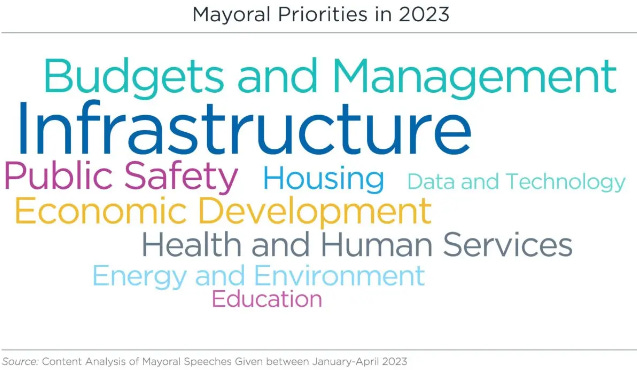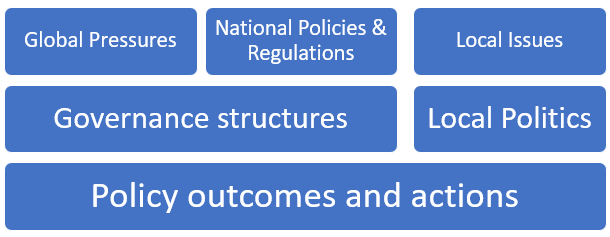City Futures 2024 - Smarter, Greener, and Inclusive? | JOHN TIBBITT from Policies for Places
New Year is the time when both individuals and governments declare new goals and ambitions. Remarkably, 2024 will be a record year for elections with over 50 scheduled presidential, government and regional elections in countries around the world including many in its largest democracies. Electors in the US, the UK, the EU, and many Asian countries including India and the Philippines have the chance to set new directions for their nations.
The world’s cities are home to over half of the people in the world and the drivers of national and local fortunes. It seems timely then to take a look at what is being proposed as priorities for city and urban development by city leaders around the world.

Cities have long demonstrated their capacity to take action on issues of widespread concern. There is a stronger global narrative around cities and climate change buoyed perhaps by the explicit recognition given to cities in the Sustainable Development Goals, especially in SDG 11. Accounts have been developed by numerous agencies illustrating how cities can drive decarbonization, resilience to climate change and economic growth. It is not hard to find examples of innovative city initiatives relating also to addressing the social consequences of urban development such as homelessness, housing insecurity and social exclusion, developing effective approaches for education and social inclusion, particularly for children from vulnerable communities, integrating sustainability and inclusivity into the cultural sector, and requiring sustainable construction practices addressing environmental concerns and green job creation. Many cities are leading the way in enabling innovative public transportation and active travel, not to mention actions to handle and respond to the Covid pandemic.
City priorities for 2024
It is instructive to look at recent statements from organisations which represent the interests of city leaders to government in different parts of the world. A European perspective is provided in a new manifesto just published by Eurocities, an organization of city leaders from over 200 larger cities across Europe. Similarly in the United States, the National League of Cities, which represents mayors from cities across the US has released its Report for 2023 which provides a review of mayoral priorities across the country.
The Eurocities manifesto emphasizes the critical role urban policy and governance will play in the EU’s future direction. It calls for an alliance to tackle the climate, digital and social challenges cities face. More specifically, it identifies 5 key strands for action:
-
A strong social agenda promoting affordable and social housing, investing in jobs and skills for green and digital transformation, and promoting health and inclusion for vulnerable groups;
-
A strong sustainability agenda for transport, energy-efficient buildings, promoting the circular economy, food systems and renewables, and ambitious targets for reduction of greenhouse gas emissions;
-
A strong digital agenda to address the digital divide, and align technological development with efficiency in public services and climate neutral goals;
-
An agenda to enhance the capacity to act through developing technical and administrative capacity and coordinated holistic approaches from local and central government agencies to incentivize local public investments;
-
A strategic approach through dialogue between city leaders and government.
On the other side of the Atlantic analysis of the issues most frequently identified in mayors’ addresses in the National League of Cities report shows their top 4 priorities to be:
-
Infrastructure
-
Budget and Management
-
Public Safety
-
Economic Development.
The figure below, taken from the 2023 NLC report shows more fully the relative importance of different topics for US city mayors.

In Asia, The Future of Asian Cities report from the United Nations Development Programme in 2019 points to four features necessary to support the sustainable urban agenda in the region. These emphasize:
-
Urban and territorial planning
-
Resilience planning in the face of climate change;
-
Smart city deployment of the best of modern technology; and
-
Appropriate financial instruments to pay for development.
One of the operational priorities of the Asia Development Bank is Making Cities more Liveable by supporting cities to become green, competitive, inclusive and resilient.
In Africa too the African Centre for Cities is working to transform global concerns to the everyday reality of African cities which show very rapid population growth and infrastructure needs.
Context for action
It is perhaps not surprising that there is a degree of overlap between these lists, although the difference in the ordering of priorities is interesting. The European listing emphasizes the importance of the social agenda, whilst in the US it is infrastructure, budgets and management which dominate. In Asia there is a strong emphasis on resilience and financial arrangements. African cities prioritize innovation, infrastructure and finance.
But if the issues for cities are similar around the world the context in which actions are formulated and delivered to address them are very different. A simple model shows factors which impinge on local decision makers.

Many of the aspects identified by city mayors reflect local responses to global issues such as climate change, carbon emissions and city resilience following the Covid pandemic. The common emphasis on climate action, clean energy transitions, and economic recovery are driven in part by these global concerns. The recognition of the importance of the utilization of technology and data is also based on their growing worldwide availability and experience with smart applications for city management and service efficiency.
National governments at state and federal levels provide a crucial part of the context for city action through their policies, legislation and regulation which determine the framework within which cities can operate. For example, the stress on a social agenda among EU mayors reflects a major plank of EU policies for social cohesion. In the US the focus on inequalities and social inclusion arises from social tensions in communities arising from issues such as migration, racial diversity, homelessness and law enforcement.
Cities have very different experiences of economic development with consequences for wealth, poverty, access to housing and employment opportunities. The innovative uses of new technologies to sustain competitive economic progress is crucial in Asia and Africa.
Underlying the formulation of innovative city responses to these issues are governance and finance arrangements. In both the EU and the US central government funding programmes are important supplements to funds available from local taxation. Post-pandemic, some government programmes are now winding down, leaving cities with decisions to make about the extent to which they can retain, or re-work initiatives originally supported by this funding. In Asia and Africa funding often depends on international arrangements which can require clear statements of the benefits which are to be expected.
Despite these constraints there are already numerous examples of successful city policy and practice innovations in response to the pressures they face which provide a significant impact on national and regional economies.
City futures 2024
Cities then can point to some real steps forward which make a difference in the lives of their citizens. There are indications not only of new directions for city policies, but also in how policies are made. Cities and commentators point to the emergence of a more participatory style of policy making as cities move towards generating policy with, instead of for residents. Such an approach promises more relevant and effective programmes and policies. It can also build connections to communities and social cohesion which may prove critical in times of increasing cultural and political polarization.
The accelerating transition to digitization and to AI allows cities to move from a narrow service-by-service mentality to a wider issue-based approach that enables participation by diverse stakeholders in problem- solving. Big impacts are expected, for example, on intelligent transportation and building performance standards. Prioritizing these approaches emphasizes the importance of tracking energy use and carbon emissions and building resilience to extreme weather and climate change. It makes it easier too to understand and allow health and social impacts to be directly included in assessing policy options.
The collection of ‘big data’ extends the possibilities for city learning and experimentation. City learning can be both within a city administration and increasingly through inter-city learning in which cities come together to explore policy or delivery options in relation to common problems and share experience. The creation of agencies which foster comparative studies are a growing feature of policy development processes.
The most striking appeal in mayors’ statements is for national and regional governments to tap into these often-under-utilized strengths of urban areas and recognize that real change does not come only, or even mainly, top-down but from daily interactions, local initiatives and place-driven projects. Local leaders seek to be engaged as genuine partners who can act on local insights and understandings as a basis for meaningful urban development and community wellbeing.
City mayors in the US at least are more confident their cities are well prepared for the future than are their citizens. More than 4 in 10 citizens in a recent study think heir city needs to make greater progress and only 42% felt their city had adequately communicated its future-ready plans. It seems clear that whilst cities will continue to be key players in addressing critical global issues on carbon transition, housing access and calls for more just and inclusive government there is much more work to be done. City streets seem paved with good intention: perhaps the systemic changes to support them are still somewhat further away.
Source: City Futures 2024 - Smarter, Greener, and Inclusive?
 Printer-friendly version
Printer-friendly version- Login to post comments







